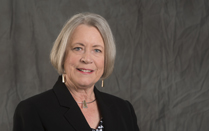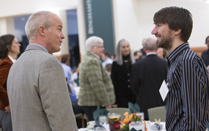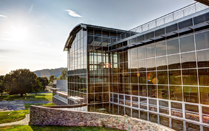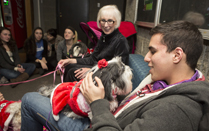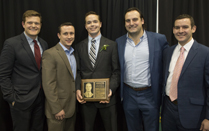Binghamton University President Harvey Stenger's Quarterly Report - December 31, 2014
I recently spent some time working out with one of the University’s yoga classes. While the class at the Appalachian Dining Hall was a great opportunity for informal networking between students and administrators, what I liked most about it was that it provided a chance to work with students in a combined exercise. Sometimes, on this campus and others I’ve been on, students, faculty and administrators seem to be operating in different universes. While everyone tends to their work and the institution continues to flourish, sometimes the distances between groups appear to be growing and the silos look like they are getting taller. The interactions I had with the students in the yoga class reminded me not only of my aging body, but also that it is important to stretch a little, to move out of your comfort zone and to relax some. Most of all, it reminded me how important it is to shake up your day and interact with other groups and individuals. Lying on a mat for 20 minutes really can change your perspective.
Looking back on the past quarter (Sept.-Dec. 2014), I can see that the University is really stretching. It’s getting bigger and better, with new students; more faculty; new schools and facilities; a growing impact in the region, state and globe; and continuing investment in the University’s future through the Road Map to Premier. At the same time, we continue to work to break down the silos and walls that divide us, replacing them with a shared commitment to success for the entire campus community.
Campus growth
Ever since NYSUNY 2020 passed in 2012, much of the University’s energy has been directed toward growing the campus, with a goal of enrolling 20,000 students by 2020. Over the past two years, we have slightly exceeded our growth target of 400 to 500 students per year; this is due in no small part to the growing reputation of our academic programs, resulting in a greater percentage of students accepting admission than in the past. Current enrollment is nearly 16,700 students, which is close to our target for 2017.
This being the season when high school seniors are applying for college, we also see that interest in Binghamton is as high as it has ever been. Freshman applications are up by more than 2,300 compared to last year at this point in time, and more than 10,000 students applied for early action consideration. Our admissions office has been paying close attention to the “yield” of applicants with regard to the academic characteristics of the incoming class, and while it is early in the admissions process, evidence suggests that next year’s incoming class will be of very high quality.
But growing the University means more than just increasing enrollment — it means hiring faculty at a rate that actually reduces the student-to-faculty ratio. We are currently in the midst of a hiring initiative that will bring a net of 150 new tenure-track faculty (TTF) to campus, significantly lowering our overall student-to-TTF ratio.
If our growing reputation allows us to recruit better students, it also helps us attract top-quality faculty. This fall we’ve hired 46 new faculty; of the 39 faculty who received PhDs from U.S. universities, 31 have come from research universities ranked in the top 50 nationally. In addition, experienced scholars and researchers have come to Binghamton from distinguished universities including Carnegie Mellon, Columbia, Wake Forest and Purdue. Hiring continues to be broad-based, involving all schools and focusing on our Transdisciplinary Areas of Excellence (TAEs). This semester we’ve conducted 64 faculty searches spread essentially evenly between Harpur and our professional schools. Forty-six of these searches revolve around specific TAEs, suggesting that University research and scholarship will advance significantly in the coming years.
Campus growth also means a need for professional and support staff. All told, 214 additional staff have been hired since 2011. While slightly more staff have been hired than faculty, the rate of increase is significantly lower, meaning that the University continues to be a lean and efficient operation.
Academic programs and facilities enhancements

We continue to move forward with our School of Pharmacy and Pharmaceutical Sciences in Johnson City. Following a very productive search, led by Graduate School Dean Susan Strehle, I’m pleased to announce that Gloria Meredith has joined us as the inaugural dean of the Binghamton University School of Pharmacy and Pharmaceutical Sciences. After four years, we will enroll 380 students, comprised of approximately 320 Pharm D students and 30 PhD students.
Not only is the campus adding new academic programs, but we are also looking closely at the pedagogy used to teach students, so that learning is active, engaging and long-lasting. Binghamton University has thrived because we value excellence in teaching and we continuously adapt our pedagogy to the changing needs of students. We take our teaching seriously, and continually look for ways to improve the classroom experience for students and faculty.
This semester the University took an innovative step toward understanding best teaching practices with the introduction of a new Learning Studio under the leadership of James Pitarresi, director of the Center for Learning and Teaching. This room is a true “learning and teaching laboratory” where faculty can experiment with pedagogy, room design and technology. Already, seven instructors are using digital technology and assessment tools to discover what works — and what doesn’t — when it comes to student-centered learning.
In October, we dedicated our Center of Excellence building at our Innovative Technologies Complex. After four years of construction, this $30 million facility is housing the Center of Excellence in Small Scale Systems Integration and Packaging (S3IP). The center has several distinct research foci, including component miniaturization, thermal management, energy optimization, and energy harvesting and storage technologies.
Protest and constructive engagement
Because Binghamton University is one of the primary institutions in the Southern Tier, I have always believed that we need to be a leader in our engagement with the broader society. This fall there have been several instances where circumstances beyond the campus gates have been reflected in the attitudes and concerns of our students and faculty. In particular, the deaths of Michael Brown and Eric Garner in Ferguson, Mo., and New York City have resulted in significant protests, on campus and across the nation.
At Binghamton, a large group of students and faculty gathered near Bartle Library and marched through campus, briefly blocking traffic near the University Union. Unfortunately, one or more persons used social media to post anonymous, derogatory and racist comments about the protesters.
In response to these vile statements, I sent out an urgent communication to the University community expressing both my embarrassment about the posts and my pride in our students, who, through their rights of assembly and freedom of speech, show that they care deeply about creating an inclusive environment, not just on our campus but in our country and world. At the same time, I noted that speech, even hateful and disrespectful speech, can be protected by the First Amendment. At a town hall meeting following these events, students discussed the campus climate and urged the campus to develop ways to increase cultural awareness on campus. During the closing weeks of the semester other senior administrators and I have been meeting with student groups to find constructive ways to address their concerns. We will continue these meetings in the spring semester.

One person who will be working to make the campus more inclusive is our new ombudsman, Bathabile Mthombeni. The ombudsman plays an important role on campus, providing independent, confidential and impartial counseling and support for individuals on campus who have concerns or grievances. Mthombeni brings a great deal of experience to campus — having previously served as an instructor of dispute resolution at the John Jay College of Criminal Justice, and as the founder and principal for Untangled Resolutions, a private mediation, negotiation and conflict management firm. Significantly, Mthombeni has also served on the New York City Civilian Complaint Review Board and has served as associate university ombuds officer for Columbia University.
Concerns about inclusivity and personal safety also are driving SUNY’s recently announced statewide uniform policy to combat sexual assault, announced by Gov. Andrew Cuomo and Chancellor Nancy Zimpher this past October. Under the terms of the new policy, consent must be “clear, knowing and voluntary.” Other provisions of the policy include amnesty for those reporting assaults with regard to other actions, such as alcohol use, that violate our Student Code of Conduct. The new policy also provides for increased training for campus police and administrators, increases confidentiality protocols, and requires campuses to develop a climate assessment regarding prevalence and attitudes toward sexual assaults.
Significantly, Binghamton already has many of these policies in place, as you can read about in the Student Affairs section of this report. The interpersonal violence prevention coordinator provides programs and events designed to increase information and awareness for students, and the University Police provide more than 100 presentations each year focusing on campus safety, personal safety and self-defense.
Economic impact for the region and beyond
The University’s community engagement also operates in the area of economic development. This quarter has seen several significant advances in this arena, beginning with the Southern Tier High Technology Incubator groundbreaking in downtown Binghamton. We had hoped to get construction under way this fall, but just as we were to go out to bid, we learned that one of our partners on this project, SUNY-Broome, was awarded an additional $6 million which allowed us add a third floor to the building. We are in the re-design phase now and hope to start full construction this coming spring. We see this as an ideal way to advance our technology transfer efforts and want to grow our own jobs. While this incubator will not exclusively be for University-related spin-offs, we do expect it to be the natural next step for research and development on campus to make its way into the private sector.
One of the University’s missions is to provide space and expertise for discussions on subjects that impact the region. This fall, Binghamton held two such meetings that expressly related to economic development and the University’s role in technology transfer. Earlier this month, we were pleased to have in attendance Assemblywoman Donna Lupardo and Assemblyman Clifford Crouch as the University hosted a special conference focusing on the NY Prize initiative — a $40 million competition to engage communities in advancing plans for local power microgrid infrastructure.
The goal of the initiative was to help communities reduce costs, promote clean energy, and build reliability and resiliency into the grid. This is important for us, since, as a modern university, the use and distribution of energy is one of our most critical administrative concerns. Each year we budget over $10 million for electricity, natural gas and other sources of energy, so anything we can do to reduce these costs means that these monies can be used to educate students and reduce the taxpayers’ burden. As a charter member of the American College and University Presidents’ Climate Commitment, the University has had a years-long commitment to reducing our carbon footprint. Over the years we have taken strong actions to reduce our energy use; for example, we are using LED lighting in our newest buildings, equipping them with geothermal heating and cooling, and continuously upgrading the components of our power plant.
A second conference this semester related more directly to the University’s role in regional economic development. As part of the SUNY Business and Education Cooperative of the Southern Tier (SUNYBEST) program, we hosted a conference organized by the Empire State Development Division of Science, Technology, and Innovation (NYSTAR). NYSTAR is one of the leading granting agencies in New York state government, with its primary goal being to support scientific endeavors that contribute to the economic development of the region and state. For example, Binghamton has benefited from NYSTAR grants to support our Center of Excellence, our Center for Advanced Technology and the Southern Tier High Technology Incubator. These investments have supported the University’s explorations into truly cutting-edge areas of research — areas such as solar energy and roll-to-roll thin film production, flexible electronics, next generation batteries, energy-use reduction, and nanomaterial manipulation and production. With a great turnout, the conference gave faculty and administrators a better idea of NYSTAR’s agenda for the future, as well as an opportunity to network with people who shape the funding process.
Perhaps the biggest event of the quarter, at least in the realm of economic development and community impact, was the news that the Southern Tier Regional Economic Development Council (STREDC) was again a top winner in Gov. Andrew Cuomo’s Regional Economic Development Council Awards ceremony, with the region receiving $80.8 million in funding for a wide range of economic development projects. The University itself will benefit in a significant way, as the STREDC proposal included $800,000 for the establishment of a Global Center on campus. This center will bring together many of the University’s international programs and offices in one central location; these offices include the Office of International Programs, International Student and Scholar Services, Languages Across the Curriculum, the Dual Diploma Program with Turkey, Global studies, English as a Second Language, and the Confucius Institute of Chinese Opera. Space vacated by our Information Technology Service (ITS) in the Computer Center will be renovated, with spaces to provide for conferences, classrooms, and international resources. Design and prep work will begin in early 2015, with construction expected to begin by next fall.
Road Map to Premier
We are now in year two of the Road Map and have just concluded the submission period for proposals for 2016-17. By the submission deadline, we had received a total of 93 submissions from across the University, indicating that the campus community is very engaged in the Road Map proposal process. At first glance, there are a number of very good proposals, so the funding process will again be very competitive. Together, the submissions targeted all of the University’s five strategic priorities, suggesting that the Road Map continues to be a valuable tool in helping move us toward our goal of becoming the premier public university. I recognize that organizing and developing these proposals is both complex and time-consuming, so I want to thank everyone for their continued work on behalf of the Road Map.
We are now deep into the implementation process. We recognize that the changes created by the Road Map, combined with the pressures of a growing campus, can occasionally make for bumpy transitions. Our goal this semester has been to identify and strengthen various supports that will allow us to achieve our strategic priorities with a minimum of disruption and upset. For example, with regard to Strategic Priority 1: Creative Activities, we have a system of supports that includes support for TAEs and new Organized Research Centers (ORCs), enhanced research space and increased faculty start-up support, among others. Similarly, some of the supports for SP2: Student Outcomes include more undergraduate research opportunities, improved advising and enhanced graduate stipends. We have developed a similar list of supports for each of the strategic priorities.
But the most important question regarding the Road Map is: “How do we know we are making progress?” We have been working with the Road Map Steering Committee to develop the right series of metrics that we can use to track our progress in reaching our strategic priorities. In the end, we have identified five metrics closely linked to the goals we want to achieve for each strategic priority. For example, under SP1: Creative Activities, some of the metrics we will be following include the number of doctorates awarded, the placement of our doctoral graduates, research expenditures, participation in interdisciplinary research and the national ranking of select graduate programs. Similar metrics have been developed for assessing progress in our other strategic priorities, e.g., the percentage of undergraduates receiving Pell grants, the number of study-abroad students and total University revenue. A full list of metrics can be found at online.
Finally, I want to take some time to recognize the achievements of our student athletes. These individuals give so much to the University community while excelling in their academic work. I especially want to congratulate the men’s cross country team that recently won the America East championship, placing five runners in the top 21 at the November meet. Three runners, seniors Matt Johnson and Jesse Garn, along with sophomore Ethan Hausmann, were each named to the all-conference team. These individuals, and all the Bearcat athletes who compete on behalf of the University, compete with integrity and help raise our visibility.
Sincerely,

Harvey G. Stenger


